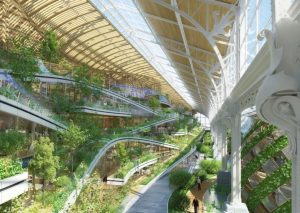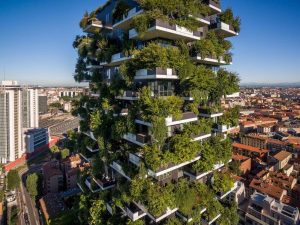Among the birds, over 60% of the species require forests. One global audit pertaining to important birds and biodiversity areas, approximately a quarter of the forests has vanished naturally and due to greed of having more and more construction work. It a serious issue, if we don’t make sweeping changes, little forest habitat will survive to the end of this century.
Biodiversity is constantly under threat worldwide. Activities such as increased development, inappropriate agricultural practices, poorly managed forestation and climate change have all threatened biodiversity with the result that many species of plants and animals are now under threat of extinction. It is vital, therefore that all sectors in society play their part in the protection of biodiversity.
Many developed and developing nations suffer from air pollution which is wreaking havoc on the health and well-being of its citizens. It is therefore very essential for innovative solutions of having more greenery to absorb the carbon dioxide in air. Because, many countries are getting highly urbanized, and there is hardly room to plant new trees.
What is a Vertical Forest?
Vertical forest is catching up in many countries across the globe. Wherein, you build a forest straight up into the sky. China’s Nanjing Vertical Forest, which is scheduled to be fully built by 2018, will bring thousands of trees and shrubs into the highly populated Pukou District of the city, absorbing tons of CO2 and producing a wealth of oxygen at the same time. Designed by famed architect Stefano Boeri, the “forest” will actually be a pair of towers absolutely covered in greenery. The taller of the two towers will stand 200 meters high, with 35 floors, and will host everything from a museum to a private club on its roof. The larger tower will even feature an architecture school specializing in green building. The smaller structure measures just over 100 meters tall and will be a Hyatt hotel with nearly 250 guest rooms. Inside the building, a complex irrigation system will redirect the water people use back onto the porches to sustain plant life.
The Nanjing Vertical Forest besides giving a pleasant surprise to eyes in the night will be extremely valuable from an environmental perspective. The structure will have 1,100 large and medium-sized trees on its facades, along with 2,500 other plants and shrubs. The plants are expected to provide 60kg of oxygen per day while absorbing over 25 tons of carbon dioxide every year. All the plant life helps reduce smog, dampen noise levels, produce oxygen, and regulate temperatures inside the two buildings. And, during the winter, sunlight can easily pass through the bare plant life and help heat people’s rooms. During the summer, the leaves can block harsh rays from making apartments too hot. The vertical forest also produce huge quantities of oxygen and can become habitats for native wildlife.
This is not the first vertical forest that Boeri has designed and built. He has to his credit a amazing vertical forest project named ‘’Bosco Verticale’’ in Milan, Italy. In Milan, the project has its own pair of towers: the construction began in 2009 and was completed in 2014, and the buildings are now residential structures. However, the Nanjing project is much larger in scale and ambition, more than doubling the number of plants as well as increasing the total height of the towers themselves. The forest is two towers at 110 and 76 metres high, with 900 trees and over 20,000 smaller plants and bushes planted on balconies on all sides of the buildings. Pruning the trees themselves took two years, Boeri says. They had to be specially designed to fit beneath balconies of varying heights.
Australia has vertical forest too, in Sydney’s One Central Park apartment project, and another planned for construction in Brisbane. The One Central Park building has won a host of international architecture awards including “Building of the Year” in 2015 and Best Tall Building from the Council of Tall Buildings and Urban Habitat.
project, and another planned for construction in Brisbane. The One Central Park building has won a host of international architecture awards including “Building of the Year” in 2015 and Best Tall Building from the Council of Tall Buildings and Urban Habitat.
Singapore’s vertical forest named ‘’Marina Bay’’ is breathtakingly beautiful at night, with 18 LED lit “Supertrees”, reaching 50 metres tall. Each “tree” is actually a concrete structure with hundreds of small plants embedded on the side. At the top of each structure are solar panels to power the park’s systems and conservatory, and rainwater tanks.
Another renowned vertical forest designer Vincent Callebaut’s has planned for an eco-neighbourhood covering a 40-hectare post-industrial site in Belgium atop wetland which will include not one but three vertical forests, and several million plants. Callebaut plans the site’s warehouses and sheds which have been repurposed into offices with a commitment to conserving energy, and the reuse of renewable power.
Dr Francesco Fiorito, a senior lecturer of architecture at the University of Sydney, says that the notion of a “vertical forest” is certainly not a publicity stunt. Dr Fiorito explains that without any greenery, traditional facades absorb energy from the sun and then re-emit some of the energy outdoors, causing an increase in outside temperatures in urban areas. Plants, as a substitute, use the energy absorbed by the sun for their living needs and as a “waste” product of this process they emit oxygen. This serves a double benefit. Besides, the evaporation of water included on plants’ surfaces, roots, soil, determines another reduction of air temperature. Dr Fioriti says there are a few reasons why vertical gardens have become more widespread, while the concept of the “vertical forest” is still in its infancy.
The vertical forest indeed has a great future!!!!














































